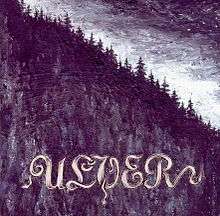Bergtatt – Et eeventyr i 5 capitler
| Bergtatt – Et eeventyr i 5 capitler | ||||
|---|---|---|---|---|
 | ||||
| Studio album by Ulver | ||||
| Released | February 1995 | |||
| Recorded | November and December 1994 | |||
| Genre | Black metal, folk metal, atmospheric black metal | |||
| Length | 34:17 | |||
| Label | Head Not Found | |||
| Producer | Ulver and Kristian Romsøe | |||
| Ulver chronology | ||||
| ||||
Bergtatt – Et eeventyr i 5 capitler (translated as "Spellbound – A Fairy Tale in 5 Chapters") is the debut studio album by the Norwegian band Ulver, issued on February, 1995 via Head Not Found. The album was recorded at Endless Lydstudio in Oslo in November and December 1994 with Kristian Romsøe as engineer and co-producer.
The album was praised for its unique atmosphere and was described as “mysterious, melancholic, eerie, and oddly tranquil.”[1] The archaic Dano-Norwegian lyrics were greatly influenced by Scandinavian folktales and inspired by Baroque poets such as Ludvig Holberg and the hymn-writer Thomas Kingo.[2]
Background
Debut album, Bergtatt, the first part of what has become known as Ulver’s “Black Metal Trilogie,”[3] was released during the rise of the Norwegian black metal subculture in Norway during the early 1990s. Separated from the more straightforward black metal of their contemporaries, Ulver incorporated elements of Norwegian folk music, utilizing acoustic guitars, droning low choirs, flutes, melody-focused songwriting and clean vocals[3] together with fast tempos, shrieked vocals, highly distorted guitars, blast beat drumming, raw (lo-fi) recording and unconventional song structures. This earned them the label “folk metal.”
Thematically speaking, Bergtatt is distinct from conventional black metal bands in the way of lyrical content. It’s laced in Norwegian mythos and fantasy, and doesn’t lend itself to the anti-Christianity of Ulver's contemporaries.[3] The title Bergtatt, translates as Spellbound – A fairy tale in 5 chapters, in Norwegian folklore the word refers to people who wander off into mountains, lured by trolls or other mythic creatures. The album's lyrical narrative follows a maiden as she becomes “mountain-taken.”
The folk-like acoustic elements of Bergtatt were isolated for their second album Kveldssanger, incorporating classical guitars, cello and choral chamber chants overlaid with subtle orchestral landscapes; while the third album, Nattens madrigal abandoned the acoustic and atmospheric elements, with an intentionally underproduced, “raw and grim black metal” sound.[4]
Speaking with Rob Hughes for Unrestrained Magazine in 2007, Rygg reflected, "We were influenced by a period known as the Kingdom of Denmark-Norway (1536—1814) — the language and literature of that era combined with the superstition and folklore of the Middle Ages. It was the kind of stuff we were learning about in school at the time. When it comes to music, we were already listening to a whole slew of other things, and already had our two next records in mind, so by the time Nattens madrigal (1997) was released, we had developed a strong urge to explore something else. We had also acquired the knowledge of how to do so in the meantime."[5]
Critical reception
| Professional ratings | |
|---|---|
| Review scores | |
| Source | Rating |
| Allmusic | |
| Pitchfork Media | (8.7/10)[7] |
| Sputnikmusic | (5/5)[8] |
AllMusic praised the album, writing, "Bergtatt is not the heaviest or most aggressive black metal around by a long shot; nor is it the most evil or blasphemous. What makes the album stand out, along with the varied vocal styles and the excellent songwriting, is its unique atmosphere—mysterious, melancholic, eerie and oddly tranquil."[6]
Angry Metal Guy stated: “Musically, the album is focused on melody and atmosphere, it blends black metal with acoustics, reverb, and gorgeous, melancholic songwriting. It even eschews Satanism in text and imagery. Except Ulver was right there when it all went down; outsiders to a scene of outsiders.”[9] Going on to acknowledge Bergtatt’s influence on Agalloch, Cormorant, Alcest and October Falls;[9] the reviewer goes on to reflect ”Bergtatt is the work of kids. These guys weren’t old, they weren’t seasoned; they were 16 and 17 when they started this band, and 18/19 when Bergtatt dropped on the famous Head Not Found label 2 years later. They were—from Garm’s own mouth—not super mature or sophisticated.“
Track listing
All tracks written by Ulver.
| No. | Title | Length |
|---|---|---|
| 1. | "Capitel I: I Troldskog faren vild" ("Chapter I: Lost in a Forest of Trolls") | 7:51 |
| 2. | "Capitel II: Soelen gaaer bag aase need" ("Chapter II: The Sun Goes Down Behind the Hills") | 6:34 |
| 3. | "Capitel III: Graablick blev hun vaer" ("Chapter III: She Noticed She Was Being Watched") | 7:45 |
| 4. | "Capitel IV: Een stemme locker" ("Chapter IV: A Voice Is Calling") | 4:01 |
| 5. | "Capitel V: Bergtatt - Ind i fjeldkamrene" ("Chapter V: Spellbound - Into the Chambers of the Mountain") | 8:06 |
| Total length: | 34:17 | |
Personnel
|
|
References
- ↑ York, William. "Bergtatt - Ulver - Songs, Reviews, Credits, Awards - AllMusic". AllMusic. Retrieved May 26, 2014.
- ↑ SØDERLIND, DIDRIK. "Ulver (Norway)". Modern Invasion Music. Retrieved May 26, 2014.
- 1 2 3 "Essential Black Metal Listening: ULVER Nattens Madrigal". Metal Injection. February 24, 2014. Retrieved May 26, 2014.
- ↑ H., Andrew (September 2, 2005). "Ulver - Nattens Madrigal". SputnikMusic. Retrieved May 26, 2014.
- ↑ Hughes, Rob (September 2007). "TRAGIC SERENADES". Unrestrained Magazine. Retrieved June 4, 2014.
- 1 2 "Bergtatt - Ulver : Songs, Reviews, Credits, Awards : AllMusic". Retrieved 12 August 2012.
- ↑ http://pitchfork.com/reviews/albums/21762-bergtattkveldssangernattens-madrigal/
- ↑ "Ulver - Bergtatt (staff review) |Sputnikmusic". Sputnikmusic. 23 December 2006. Retrieved 12 August 2012.
- 1 2 "Yer Metal Is Olde! Ulver – Bergtatt". Metal Injection. April 20, 2014. Retrieved May 30, 2014.